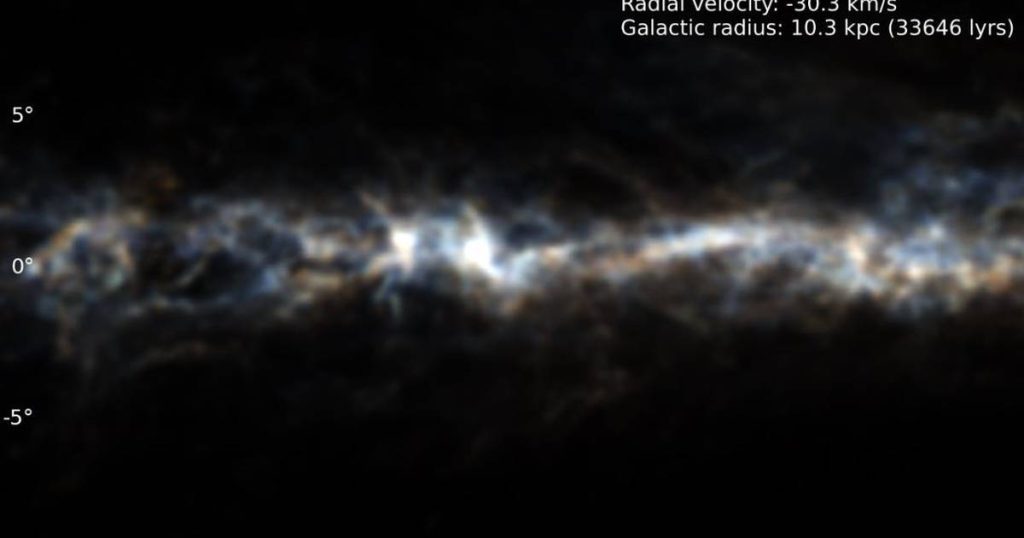Madrid 24 (European press)
The scientists analyzed the filamentous structure in the atomic hydrogen gas emission detected in the HI4PI survey, which provides the most detailed distribution of atomic hydrogen to date in the Milky Way. They concluded that it preserved a record of the dynamic processes resulting from ancient supernova explosions and the rotation of the galaxy. Their results were published in the Journal of Astronomy and Astrophysics.
Hydrogen is the main component of stars like the sun. However, the process that drives the diffuse clouds of hydrogen gas that spread throughout our galaxy to gather into the dense clouds from which stars eventually form is still not fully understood.
A collaboration led by Juan Diego Soler of INAF-IAPS (Istituto di Astrofisica e Planetologia Spaziali, an INAF Research Institute in Rome) and the ECOgal project has now taken an important step in elucidating the life cycle of the raw material for star formation.
Soler processed data from the most detailed full-sky study of atomic hydrogen emissions in radio waves, the HI4PI study, which is based on observations obtained with the 64-meter Parkes Radio Telescope in Australia, the 100-meter Eiffelsberg Radio Telescope in Germany, and the Robert C. Bird Green Bank 110 meters (GBT) in the United States.
“These archival observations of the hydrogen emission line at a wavelength of 21 cm contain information about the gas distribution in the sky and its velocity in the direction of observation, which combined with the Via Lactea rotation model indicates the distance,” says Sergio Molinari of INAF-IAPS, principal investigator on the ECOgal project.
To study the distribution of hydrogen clouds in the galaxy, Soler applied a mathematical algorithm commonly used in automatic scanning and analysis of satellite images and online videos. Due to the size of these observations, it was impossible to perform this analysis with the naked eye.
The algorithm revealed a vast and complex web of thin thread-like objects or threads. Most of the filaments are found in the inner part of the Milky Way, moving away from the disk of our galaxy.
“These are likely the remnants of multiple supernova explosions that swarm the gas and form bubbles that burst when they reach the characteristic size of a galactic plane, like bubbles that reach the surface in a glass of sparkling wine,” says Ralph Klissen.
Klessen is also the principal investigator on the ECOgal project, which aims to understand our galactic ecosystem from the disk of the Milky Way to the sites of star formation and planets. “The fact that we see mainly horizontal structures in the outer Milky Way, where there is a sharp decrease in the number of massive stars and therefore fewer supernovae, indicates that we are recording the input of energy and momentum from the gas-forming stars in our galaxy,” says the astronomer. Resident at the Astronomy Center at Heidelberg University in Germany.
“The interstellar medium, which is the matter and radiation found in interstellar space, is regulated by star formation and supernovae, the latter being the violent outbursts that occur during the last evolutionary stages of the ten-fold star. Says Patrick Henbell, who with Klessen coordinates theoretical work on the ECOgal project” .
“Supernova assemblies are very effective in maintaining turbulence and lifting gas in a stratified disk,” explains the researcher from the Department of Astronomy at CEA/Saclay in France. “Finding these filamentous structures in atomic hydrogen is an important step in understanding the galactic-wide process responsible for star formation.”

“Beer enthusiast. Subtly charming alcohol junkie. Wannabe internet buff. Typical pop culture lover.”


:quality(85)/cloudfront-us-east-1.images.arcpublishing.com/infobae/672PTL7FMJCOJDMBVMYE5EO4XU.png)
:quality(85)/cloudfront-us-east-1.images.arcpublishing.com/infobae/JQACT5BSDVCMHIRHSG7JFMNQKA.jpg)



More Stories
Amazon Ads launches AI image generator
The new discovery exposes a major misunderstanding of dark energy
The Voyager 1 spacecraft sends information back to Earth after five months without sending signals